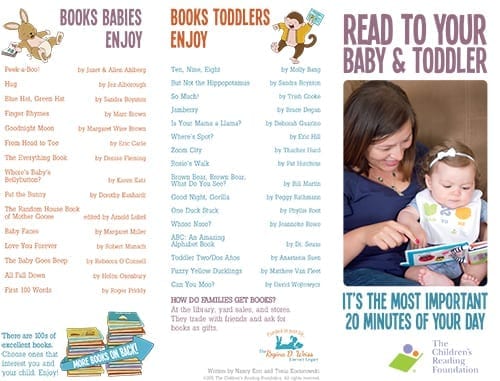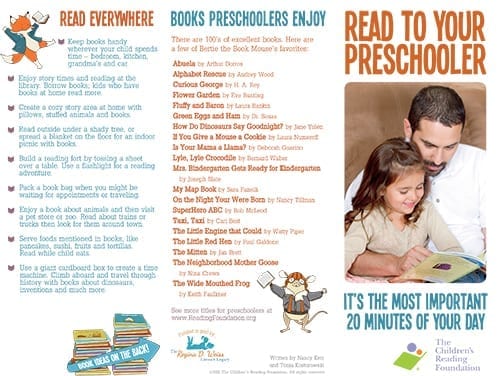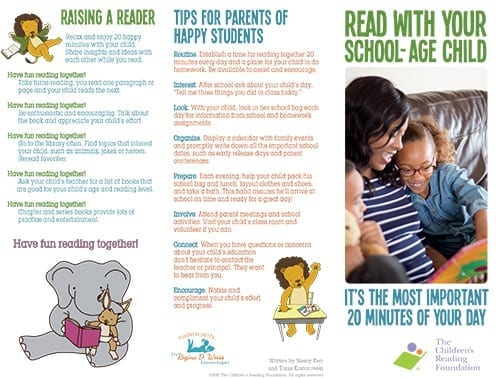Tips for Reading With a Child
What You Do Matters
Reading with your child is so much more than simply saying the words on the page. It should be a conversational dance back and forth between the reader and the child. Be sure to pick a comfortable, well-lit spot when you read together and make that special time a daily routine. Keep reading with your children as they grow older and can read on their own. Kids still enjoy that bonding time with you. As their reading skills mature, reading together looks different at every stage. What should always be constant is reading together every day.
Enrich the Reading Experience
As you read with a child, it increases his or her brain activity (American Academy of Pediatrics), giving the child a strong literacy and language foundation. Reading together is also an amazing way to bond together. Where is a child going to feel more loved than on your lap or next to you on the couch with your undivided attention?
While you’re reading, enrich the reading experience in any number of ways.
Take your baby’s finger and point to an object in the story or ask your toddler to point to the object. Ask your preschooler to complete a rhyme within the story. Ask open-ended questions about what’s taking place on the page or in the story or ask them how the story relates back to their life.
Enhance the experience by talking about what’s on the pages such as the colors, letters, and pictures, as well as talking about what’s taking place in the story. You can’t be too silly when reading with your child, the crazier and more exaggerated the voices, the better! Using one or all of these suggestions will ensure the reading experience is enriched for both you and your child. Here is a great example of a great read aloud by Michael Rosen, author of We’re Going on a Bear Hunt.
Reading Tips: All Ages
Always read the title of a book as well as the name of the author and illustrator when you begin reading. Discuss with your child how a book is read from left to right, and the different parts of a book. Keep books in multiple areas where your kids can access them.
Choose books that interest your children. That’s the best way to get them excited about reading! Ask your child questions about what’s illustrated on the pages, what is happening in the story, and what your child thinks is going to happen next. Also, ask how they would change the story.
Whether these are questions your child is able to answer, or you answer for them, it is a great way to expand the reading experience.
Reading With Infants
Infants enjoy bright and bold books with contrasting illustrations. Board books, cloth, and bath books are ideal because babies put everything in their mouths.
Keep books in areas of your home where your baby can safely reach them. As your child reaches 6 months, he or she will love to help you turn the pages and lift up the book. Singing the lines is a great way to read with an infant. Babies and young children learn through repetition, so don’t be afraid to read and reread the same book often.

Read With Your Baby/Toddler Brochure
Reading With Toddlers
Toddlers love an active experience when reading. They love to lift flaps, scratch different textures, and find objects in the pictures. Books with rhymes, patterns, and songs are ideal for toddlers. Have your toddler act like one of the characters in the story.
If your child won’t sit still for an entire book, that is fine! Toddlers usually have shorter attention spans than infants. Look for text that is short and simple. Read a few pages, several times a day when they are interested. You can also bring your child's activeness into the story by asking them to find a toy that is the same color, shape or object as something in the story.
Reading With Preschoolers
When reading with your preschooler, choose books that provide opportunities for discussions between you and your child. At this age, children are able to sit and listen to longer stories. Act out or predict parts of the story. It is also a great time to connect parts of the story to things happening in your child's life.
Allow your preschooler to ask questions as well as answer your questions to demonstrate they understand the story: Who are the characters? Which character are you like the most? Where did the story take place? What is happening in the picture on this page? Would you do what the mouse did? Why not?
Your preschooler is still building vocabulary and communication skills. Be sure to allow plenty of time for the child to respond by counting to five silently in your mind. This is called “wait time” and shows respect for a child’s growing thinking and speaking skills.

Read With Your Preschooler Brochure
Reading With School-Age Children
Younger school-age children will benefit from reading activities that emphasize the three primary subareas of reading: accuracy (reading without making mistakes), fluency (reading with speed, accuracy, and proper expression), and comprehension.
By third grade, most children are reading by themselves. However, it is important to continue reading aloud together to further develop essential skills with more challenging reading material. Plus, it is a positive, rewarding experience.
When you read aloud, you can read books at your child’s listening level, which is higher than his or her reading level. The wonderful, unique words found in children’s literature are often words we do not use in everyday conversations. Reading more challenging reading materials provides the opportunity to expand your child’s vocabulary. A large vocabulary will improve comprehension as your child reads more advanced books.



